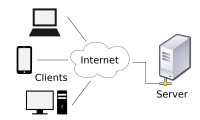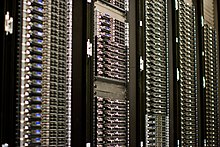


A server is a computer that provides information to other computers called "clients" on a computer network.[1] This architecture is called the client–server model. Servers can provide various functionalities, often called "services", such as sharing data or resources among multiple clients or performing computations for a client. A single server can serve multiple clients, and a single client can use multiple servers. A client process may run on the same device or may connect over a network to a server on a different device.[2] Typical servers are database servers, file servers, mail servers, print servers, web servers, game servers, and application servers.[3]
Client–server systems are usually most frequently implemented by (and often identified with) the request–response model: a client sends a request to the server, which performs some action and sends a response back to the client, typically with a result or acknowledgment. Designating a computer as "server-class hardware" implies that it is specialized for running servers on it. This often implies that it is more powerful and reliable than standard personal computers, but alternatively, large computing clusters may be composed of many relatively simple, replaceable server components.
- ^ "1.1.2.2 Clients and Servers". Cisco Networking Academy. Archived from the original on 2024-04-07. Retrieved 2024-04-07.
Servers are hosts that have software installed that enable them to provide information...Clients are computer hosts that have software installed that enable them to request and display the information obtained from the server.
- ^ Windows Server Administration Fundamentals. Microsoft Official Academic Course. Hoboken, NJ: John Wiley & Sons. 2011. pp. 2–3. ISBN 978-0-470-90182-3.
- ^ Comer, Douglas E.; Stevens, David L (1993). Vol III: Client-Server Programming and Applications. Internetworking with TCP/IP. West Lafayette, IN: Prentice Hall. pp. 11d. ISBN 978-0-13-474222-9.